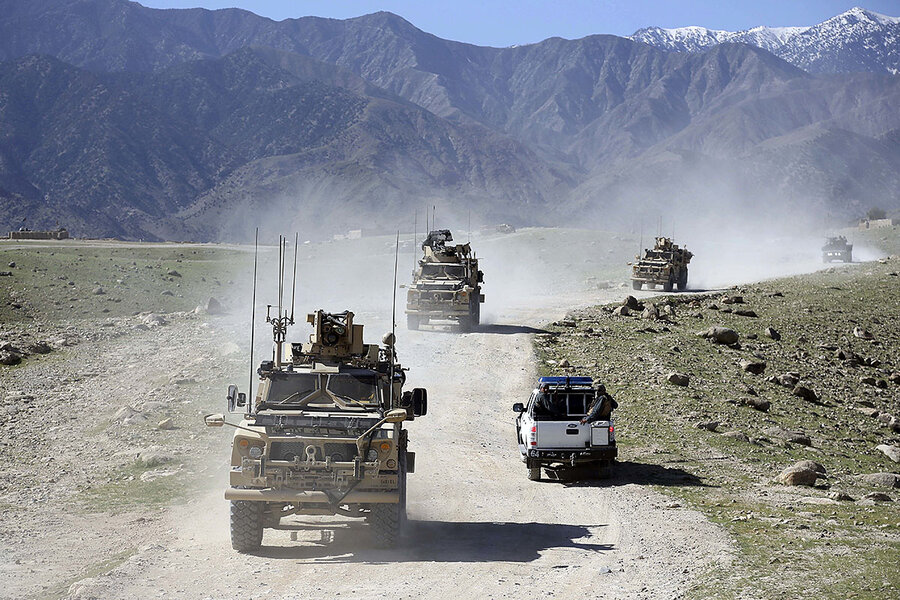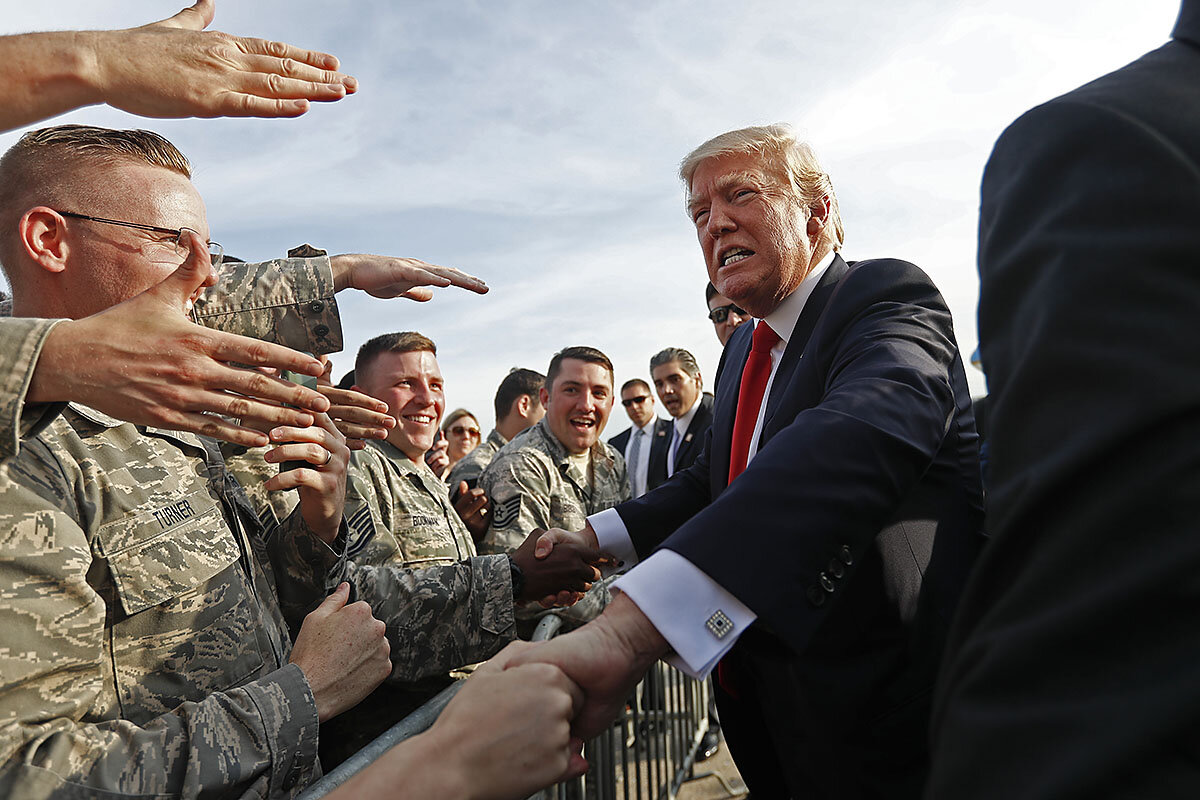Trump call on Afghan surge: Another step away from 'America First'?
Loading...
| Washington
On the scale of the foreign-policy issues President Trump has to consider, the proposed surge of up to 5,000 more US troops into Afghanistan may not register as the most pressing.
Compared with the nuclear threat posed by North Korea (another missile test over the weekend), or the challenge of defeating the self-declared Islamic State (Turkey’s president is in Washington May 16 amid a sharp dispute over the US arming of Syrian Kurds), to surge or not to surge once again in what has become America’s longest military engagement might be relatively small foreign-policy potatoes.
But an Afghan surge would be Mr. Trump’s first significant commitment of US troops to war – he has dispatched a few hundred to Syria to help fight ISIS there – and as such his decision will offer clues to how this new president intends to resolve the contradictions in his foreign policy vision.
How Trump comes down on Afghanistan will offer hints as to how far he intends to go with the “America First” theme of his campaign – or whether he will pursue the shift toward a more traditional exercise of American power and leadership that has characterized his early foreign-policy decision-making.
The White House has suggested Trump will make a decision on Afghanistan troop levels before he attends a meeting of NATO leaders May 25 – but all indications are he is poised to accept the recommendation of his top national security advisers, whose influence has grown steadily in the first months of his administration, and add at least several thousand troops to the 8,400 now in Afghanistan.
And if he does, foreign policy analysts say, it will be further evidence that the inward-focused worldview inherent in “America First” is losing out.
Trump is “having trouble sticking to the ‘America First’ approach to foreign policy that he advocated in the campaign, and there’s a reason for that,” says Bruce Jentleson, a former State Department policy planning official who is now a professor of international relations and diplomacy at Duke University in Durham, N.C. “He’s finding out that ‘America First’ is hard to do in a way that doesn’t leave you shooting yourself in the foot.”
Trump was going to label China a currency manipulator and slap steep tariffs on its goods, but then it became clear the US needed good relations with China – to help rein in North Korea, among other things.
Trump was going to withdraw from NAFTA, but then the farmers in the counties that voted most heavily for Trump made it clear to the president that they depend on the trade deal with Mexico and Canada.
NATO was obsolete and too expensive – until after Trump took office, when he described the Alliance as “the bulwark of international peace and security.”
Afghanistan illustrates that dilemma, too, Professor Jentleson says. According to the nationalist vision that candidate Trump espoused, the US would be quickly extricating itself from conflicts it had no business getting into in the first place – from Afghanistan to Iraq and on to Syria.
But Trump also pledged to take on “radical Islamist terrorism” more aggressively and destroy it. That won’t be done simply by hunkering down at home.
“There was always a contradiction in how he was going to confront national security challenges and other international issues,” says Jentleson.
“On Afghanistan and tackling the terrorism threat more broadly, it was ‘I’m going to bash the bad guys more than anyone has before me,’” he says, “but then it was also, ‘Oh wait, if I’m going to make America great again, I don’t want to make those expensive commitments.’”
'Hawkish' side's advantage
It should not be too surprising that a new president with no foreign-policy experience would gravitate, once in office, toward a more conventional policy line and away from some of the more sensational positions staked out in the campaign. But some of Trump's key steps since he took office also explain the pattern his foreign policy is following, some experts say.
“The tensions in Trump’s foreign policy go as far back as the beginning of the campaign, when he would express deep skepticism about involvement in distant wars and nation-building – only to counter that with very hawkish language about how he would defeat ISIS and Al Qaeda,” says John Glaser, associate director of foreign policy studies at the Cato Institute in Washington.
If Trump’s more “hawkish” side is winning the day, it’s in part because the president decided early on to give his generals more latitude and greater say in decision-making, Mr. Glaser says. “Trump basically said, ‘You develop the strategies and I’ll support you,’ and so in Afghanistan you get a bigger US presence on a roughly permanent basis – which is what [the generals] have wanted for a long time.”
For Glaser, another explanation for the evolution in Trump foreign policy is the thin stable of advisers he had to draw on when he took office.
“When he came in he didn’t have a deep bench to work with on all these issues, so he was left to turn to the military, the intelligence community, and the foreign-policy community,” he says. “But the bulk of those people tend to have really hawkish and interventionist views.”
Bannon opposing the surge
Again, Afghanistan is a case in point. Trump came into the White House with chief strategist Steve Bannon, who continues to counsel the president to stay out of Middle East wars and focus on the home front. But Mr. Bannon – who was initially named a principal of the National Security Council before having the lofty position stripped away – has seen his star fall as those of national security adviser H. R. McMaster and Defense Secretary Jim Mattis have risen.
Reports trickling out of the White House portray a jilted Bannon trying desperately to convince his boss that the Afghan troop surge recommended by General McMaster and the Pentagon would betray the worldview that carried Trump into office.
Proponents of sending more troops to Afghanistan say it would allow the US to work more closely with the NATO-trained Afghan security forces and to build pressure on the Taliban to come to the negotiating table.
Skeptics, among them Jentleson and Glaser, say a few thousand more US troops will have virtually no chance of influencing a stalemated war that is fueled by unresolved political conflicts and corruption.
Yet while that may be true, Jentleson says that other than the occasional flash of an America First impulse, he expects Trump’s evolution to a more traditional internationalist foreign policy to continue.
“When Trump handed [German Chancellor Angela] Merkel a bill at the White House for what he says Germany owes NATO, I guess that was a bit of America First,” Jentleson says. “But there’s a difference between that sort of thing and getting the best deal you can for the country.”







